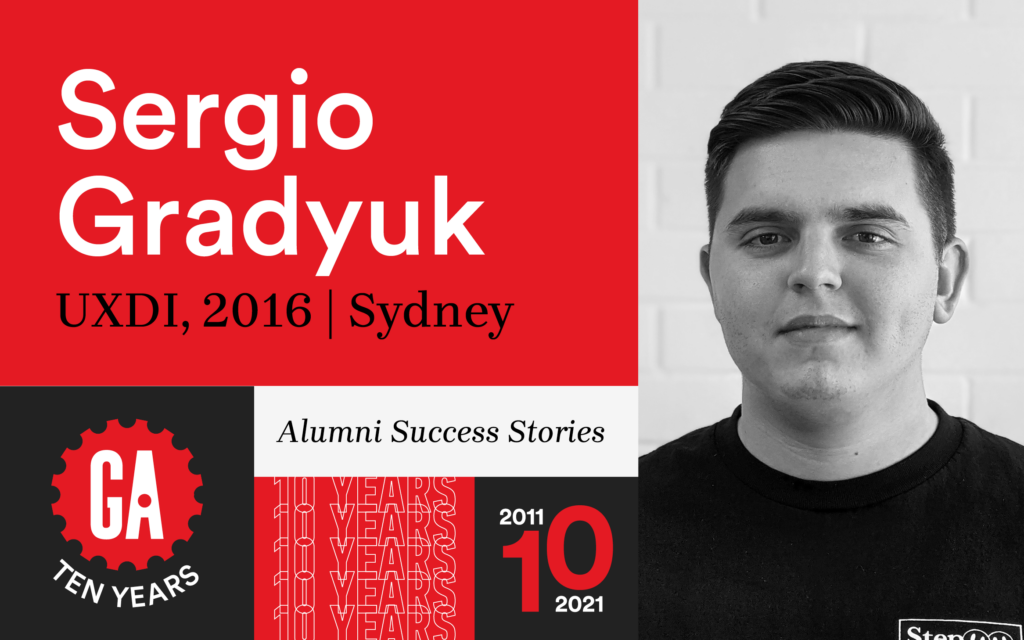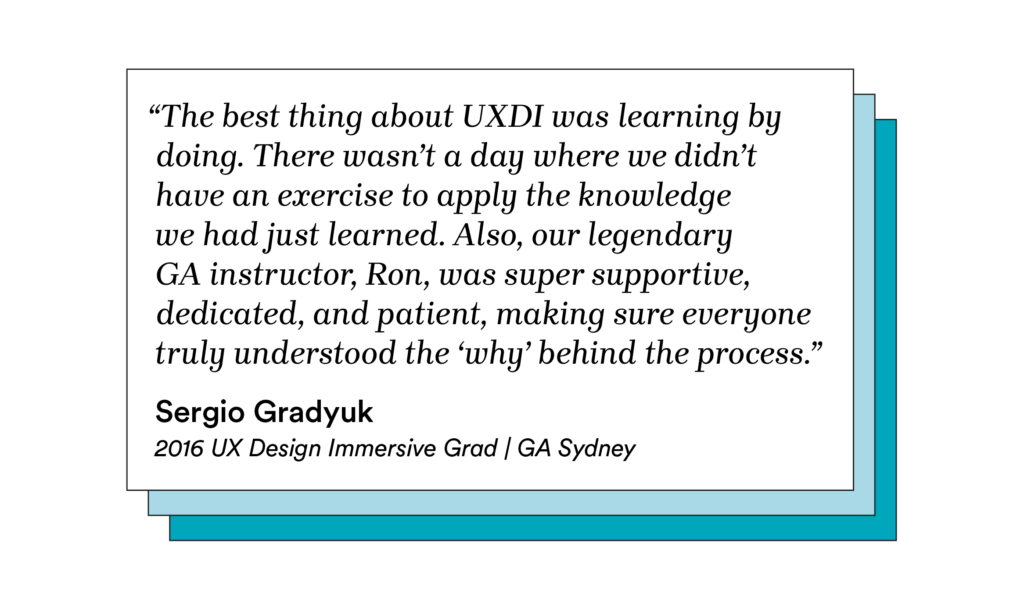
Any freelancer knows that good work gets more work. That’s why Sergio Gradyuk, a self-taught freelance visual designer, turned to GA’s User Experience Design Immersive (UXDI) program to take his technical skills and career to the next level. Read on to learn how he used General Assembly insights to strengthen his portfolio, stay ahead of competition, and co-found his design studio, Oakland Studio.
My name is Sergio, and I run Oakland Studio, a design studio based in Brisbane, Australia. Design and business are my two major interests so that led me to a career in UX and launching my own design studio.
Instead of enrolling in university after high school, I designed an app for a cafe chain I worked for as a graphic designer to help customers order ahead of time. That sparked my passion for design, so I studied everything I could and started doing concept designs for big companies to build a portfolio I could use to win some freelance work.
What were you doing before you came to GA? What was difficult or dissatisfying about it that prompted you to make a change?
Freelancing was great. I learned a lot on my own, but I felt like I was missing key fundamentals. I was primarily focused on the web and knew there was a whole world of product design still to explore. It seemed super daunting, but I knew it was the next step in my career.
What was it about UX design specifically that intrigued you to explore it as a career? What were the defining moment/s that pushed you to move forward?
The first time I learned more about UX beyond the buzzword was when I realized it would be an opportunity to mix visual design with data and business requirements. The part that intrigued me the most was knowing that these key fundamentals would be useful to me in the future no matter which direction I took with my career.
What motivated you to choose GA over other programs?
Seeing its success in America with the world’s leading companies and most exciting startups validated General Assembly as the source of truth for learning the fundamentals.
What was the best thing about UXDI for you? And the GA experience overall, both during and after?
Learning by doing. There wasn’t a day that went by where we didn’t have an exercise to apply the knowledge we had spent hours learning. Also, our legendary GA instructor, Ron, was super supportive, dedicated, and patient, making sure everyone truly understood the why behind the process.

Describe your career path after completing the program. How has GA been a resource to you in terms of finding a job?
After completing my GA Immersive coursework, I faced a job search which proved difficult with my young age. I was eventually offered a UX position at an agency. GA helped me find opportunities in Sydney, as well as Brisbane when I moved back up. What was really helpful though was having access to all of the learning resources even after the course ended. It meant that I could keep refining and revisiting my process, and it has been instrumental to my professional development and confidence.
Tell us more about your company, Oakland Studio. What inspired you to start your own business?
Oakland is a boutique studio focused on brand, visual direction, and product design. The majority of our work is taking an idea for a product — whether it be a startup or an enterprise company looking to do something new — and take it to the minimum lovable product and beyond.
The inspiration to start my own business was seeing an opportunity in the Australian market to meet a global standard and relevance with work. I’ve always planned to start a business and saw this as an opportunity to gain exposure to startups, VCs, enterprise, etc., while focusing on what I love.
What do you love most about being your “own boss?” What’s been the most challenging?
The biggest thing is owning your wins and losses. When you lose, it hurts. When you win, there’s no better feeling to know that you’re growing and investing time into something you own. It’s always challenging and requires a lot of work, but every stage of growth brings something new to learn and fun problems to solve.
Do you have any advice for GA students who want to start their own business?
I had to sacrifice both my personal and professional life for a while as I got started. It’s not for everyone, and I disagree with the glorification of “entrepreneurs.” What’s important is to audit yourself, identify your priorities, and know that it’s something you absolutely must be dedicated to.
How has GA made an impact in your career?
If it weren’t for GA, then I wouldn’t have a UX Career.
In respect to UX, what do you want your legacy to be? Is there a change you want to inspire or a mission that defines the work that’s important to you?
The change I want to see is for graduates and designers to open themselves up to the entire sphere of design, especially in digital products. Don’t lock yourself into just UX — understanding and being able to execute in the whole value chain from UX to development (and even in brand and marketing) will make you a force to collaborate with. Keep learning by doing and jumping into those challenges.